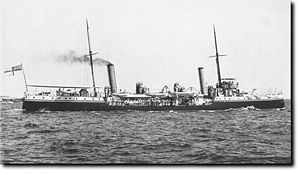HMS Hussar (1894)
 HMS Hussar | |
| Career (United Kingdom) | |
|---|---|
| Name: | HMS Hussar |
| Builder: | Devonport Dockyard |
| Laid down: | 3 April 1893[1] |
| Launched: | 3 July 1894 |
| Commissioned: | 3 December 1896[1] |
| Fate: |
Sold for scrap in December 1920 Resold on 13 July 1921 |
| General characteristics | |
| Class and type: | Dryad-class torpedo gunboat |
| Displacement: | 1070 tons |
| Length: | 262 ft 6 in (80.01 m) |
| Beam: | 30 ft 6 in (9.30 m) |
| Draught: | 13 ft (4.0 m)[1] |
| Installed power: | 3,500 ihp (2,600 kW) |
| Propulsion: |
|
| Speed: | 18.2 kn (33.7 km/h) |
| Complement: | 120 |
| Armament: |
|
HMS Hussar was a Dryad-class torpedo gunboat[1] of the Royal Navy. She was launched in 1894 and served in the Mediterranean between 1896 and 1905 before being used for fishery protection. During the Dardanelles campaign of 1915 her commanding officer and two of her ship's company won the Victoria Cross. She was broken up in 1921.
Contents
Design
Ordered under the Naval Defence Act of 1889, which established the "Two-Power Standard", the class was contemporary with the first Torpedo Boat Destroyers. With a length overall of 262 ft 6 in (80.01 m),[1] a beam of 30 ft 6 in (9.30 m)[1] and a displacement of 1,070 tons,[1] these torpedo gunboats were not small ships by the standard of the time; they were larger than the majority of World War I destroyers. Hussar was engined by Hawthorn Leslie and Company[1] with two sets of vertical triple-expansion steam engines, two locomotive-type boilers, and twin screws. This layout produced 3,500 indicated horsepower (2,600 kW),[1] giving her a speed of 18.2 knots (33.7 km/h).[1] She carried between 100 and 160 tons of coal and was manned by 120 sailors and officers.[1]
Armament
When built Hussar acquired a different armament from the rest of the class; she was fitted with one (instead of two) QF 4.7-inch (12 cm) gun, one (instead of four) 6-pdr guns and two additional 12-pdr guns. Her primary weapon was five 18-inch (460 mm) torpedoes, with two reloads.[1] On conversion to a minesweeper in 1914 two of the five torpedoes were removed.[1]
History
Yacht to the Commander-in-Chief, Mediterranean
In 1907 Hussar had her armament removed and was converted to become the yacht and despatch vessel for the Royal Navy's Commander-in-Chief, Mediterranean.[2]
Fitted as a minesweeper
In 1914 she was adapted as a minesweeper, which was the fate of many such torpedo gunboats.
Dardanelles (1915)
In February 1915, Commander Edward Unwin took command of the Hussar. For the landing at Cape Helles, 25 April 1915, Unwin took command of the SS River Clyde. Unwin won the Victoria Cross for his actions during the landing, as did two of his crew from the Hussar who were also on the River Clyde, Able Seaman William Williams and Seaman George Samson.
Disposal
Hussar was initially sold in December 1920, but was resold on 13 July 1921 to L Gatt, of Malta for breaking up.
References
- ↑ 1.00 1.01 1.02 1.03 1.04 1.05 1.06 1.07 1.08 1.09 1.10 1.11 1.12 1.13 1.14 Winfield, Rif; Lyon, David (2003). The Sail and Steam Navy List, 1815-1889. Chatham Publishing. ISBN 978-1861760326.
- ↑ "HMS Hussar at the Index of 19th Century Naval Vessels". http://www.pbenyon.plus.com/18-1900/H/02342.html. Retrieved 2009-02-24.
Colledge, J. J.; Warlow, Ben (2006) [1969]. Ships of the Royal Navy: the complete record of all fighting ships of the Royal Navy (Rev. ed.). London: Chatham. ISBN 9781861762818. OCLC 67375475.
| ||||||||
